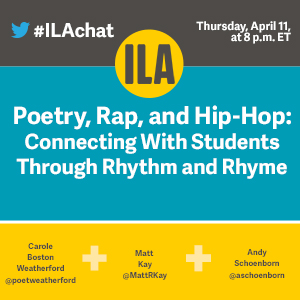 April is National Poetry Month, a 30-day celebration of rhythm and rhyme and creatively crafted turns of phrases. That seems the perfect time for us to explore poetry in all its forms as a way to engage students—the topic of our next #ILAchat, which will occur at 8:00 p.m. ET on Thursday, April 11.
April is National Poetry Month, a 30-day celebration of rhythm and rhyme and creatively crafted turns of phrases. That seems the perfect time for us to explore poetry in all its forms as a way to engage students—the topic of our next #ILAchat, which will occur at 8:00 p.m. ET on Thursday, April 11.
I’ve liked poetry for as long as I can remember. I took to rhyming early on; in my youth, I was big fan of hink pinks (and their longer brethren hinky pinkies), and Dr. Seuss was favored reading material. I wrote poetry for my high school literacy magazine and was the coeditor of that magazine my senior year. To this day, I enjoy the challenge of writing in rhyme, a task I get to undertake in a few tweets a year during National Poetry Month.
I still remember some of the reactions to my poems when they were read during the submission reviews (more so than those vocabulary words I was supposed to have memorized!). I could probably recite parts of those pieces even though I wrote them more than 20 years ago, and certainly haven’t read them in a decade.
I could also recite Edgar Allan Poe’s “Annabel Lee,” the beginning of Lewis Carroll’s “Jabberwocky,” and a good chunk of Samuel Taylor Coleridge’s “The Rime of the Ancient Mariner.” These poems spoke to me as a child, and I’ve held on to them ever since. I can’t tell you how many times I read the news and think,
“Turning and turning in the widening gyre
The falcon cannot hear the falconer;
Things fall apart; the centre cannot hold;
Mere anarchy is loosed upon the world.”
Thank you, William Butler Yeats.
My love for poetry didn’t end in high school nor hold to only the “classics.” I became a big fan of Kwame Alexander after seeing him keynote—and meeting him briefly—at ILA 2016 (which goes to show the power of meeting authors in person). Poetry is an ever-evolving art form, and modern poets like Morgan Parker and nayyirah waheed changed my understanding of poems; there is no set form or design. A poem can bloom outward into one hundred lines or be a handful of poignant words, and both have the power to play upon the heartstrings of the reader.
Poetry has the potential to captivate, whether just from the enjoyment of the cadence of the words or the power of the meaning. With various forms and structures (acrostic, limerick, haiku, villanelle), poems can be as much of a challenge to write as the author wants to make them—it’s up to the writer to find where it’s fun. Poetry can reach students where they are, speak to them when they most need it and give them a voice when normal words or writing structures just aren’t enough. Poems are such a powerful way to engage students in reading and writing, it seems a shame to have only a single month celebrating them!
My hope for this #ILAchat is that educators see the value and potential in bringing poetry into classrooms, libraries, schools, and other learning environments throughout the year. I keep using the words poetry and poems as generic terms. To reach all students, educators should use the entire gamut of the genre, and that includes songs, hip-hop, slam poetry, and rap.
Guest experts
Joining us on this exploration of poetry in all its forms are poem enthusiasts Carole Boston Weatherford, Matt Kay, and Andy Schoenborn.
Weatherford composed her first poem in first grade and dictated the verse to her mother on the ride home from school. Since her literary debut with Juneteenth Jamboree in 1995, Weatherford’s books have received three Caldecott Honors, two NAACP Image Awards, a Society of Children's Book Writers and Illustrators Golden Kite Award, a Coretta Scott King Author Honor, and many other honors. She is a professor of English at Fayetteville State University in North Carolina.
A proud product of Philadelphia’s public school system and a graduate of West Chester University and California University of Pennsylvania, Kay is a founding teacher at Science Leadership Academy, where he teaches an innovative inquiry-driven, project-based curriculum. He is also the founder and executive director of Philly Slam League, a nonprofit organization that shows young people the power of their voices through weekly spoken word competitions.
Schoenborn is an author and high school English teacher in Michigan at Mt. Pleasant Public Schools. He focuses his work on progressive literacy methods, including student-centered critical thinking, digital collaboration, and professional development. He is a past president of the Michigan Council of Teachers of English, a Chippewa River Writing Project Teacher Consultant, a Michigan Reading Association Regional Representative, and a #TeachWrite cofacilitator. He frequently conducts workshops related to literacy and technology and shares his thoughts on literacy through his blog elafieldbook.wordpress.com and in #TeachWrite Twitter chats. Contact him on his website andrewschoenborn.weebly.com.
We hope you’ll join our discussion about poetry and come with ideas on how educators can bring poems into their students’ lives, not just this month, but throughout the year.
See you there!
Wesley Ford is the social media strategist for ILA.